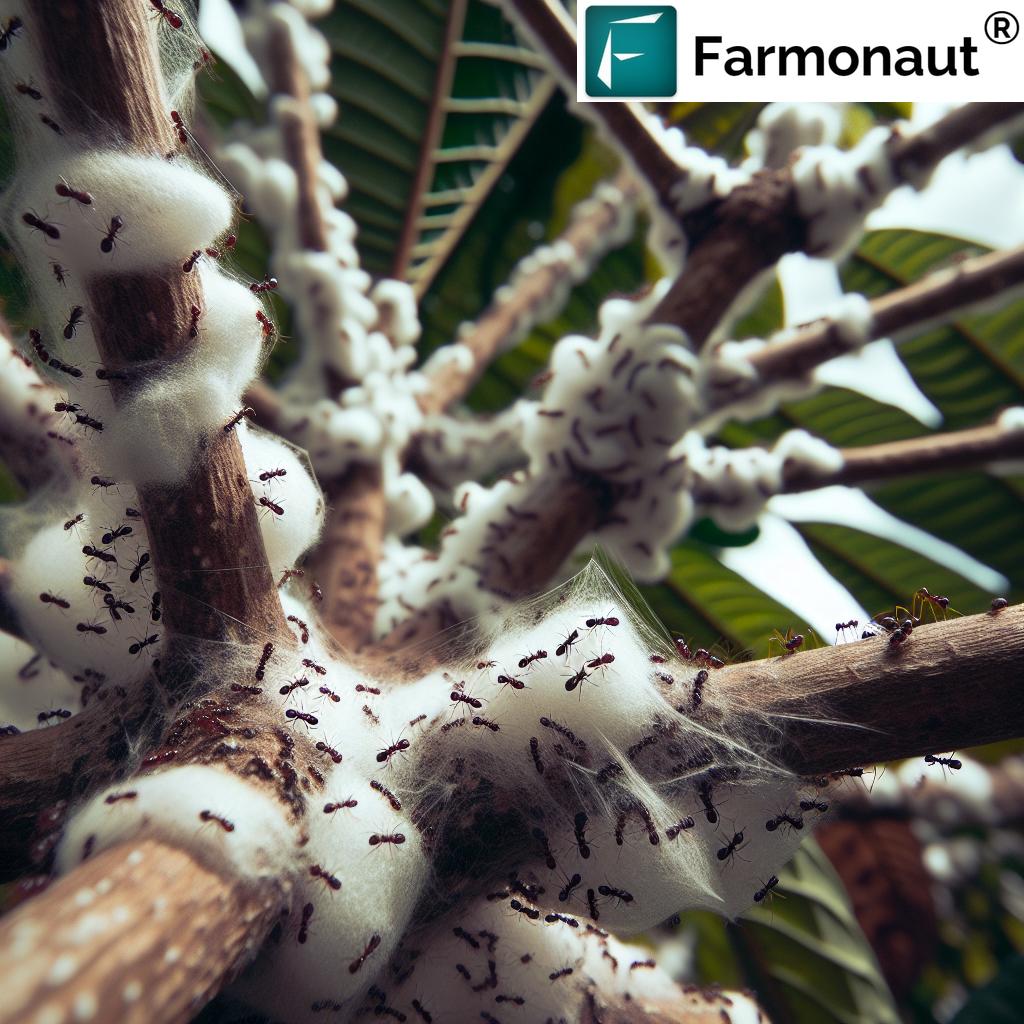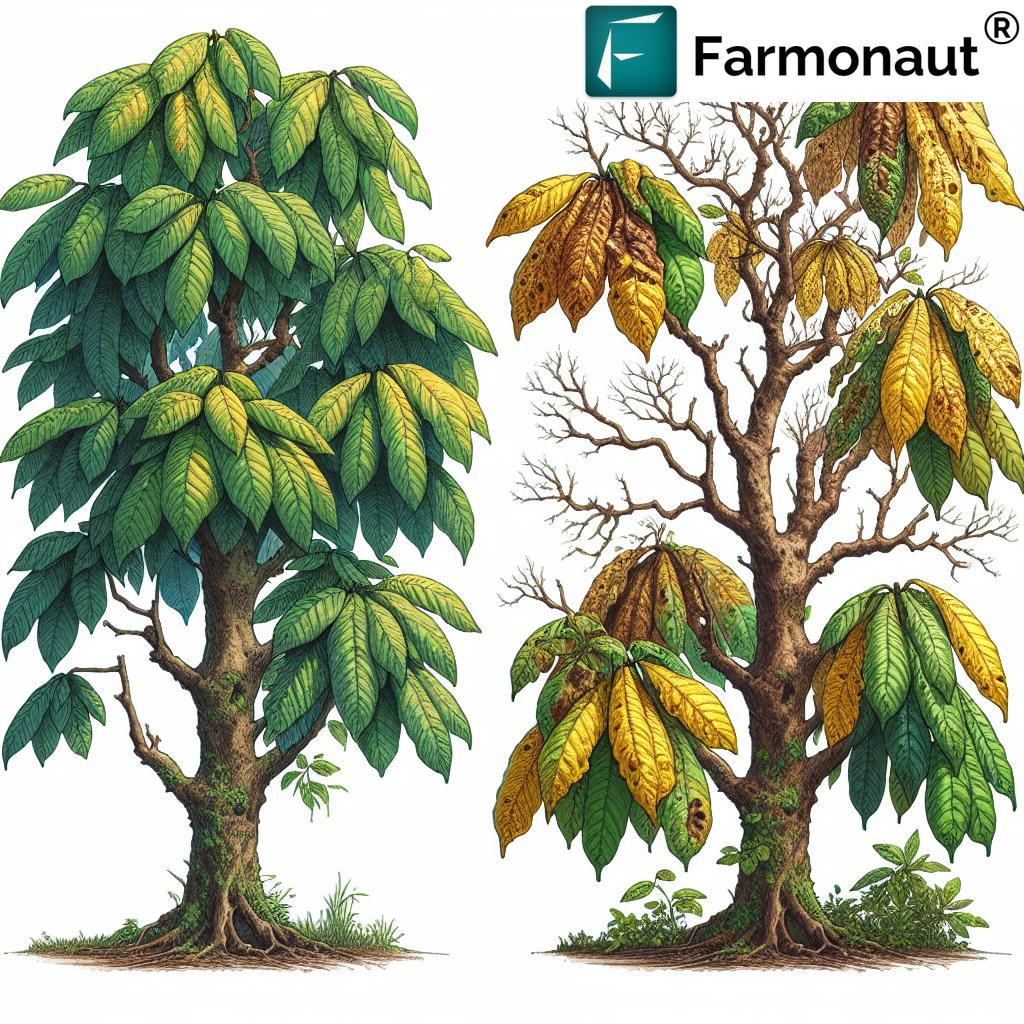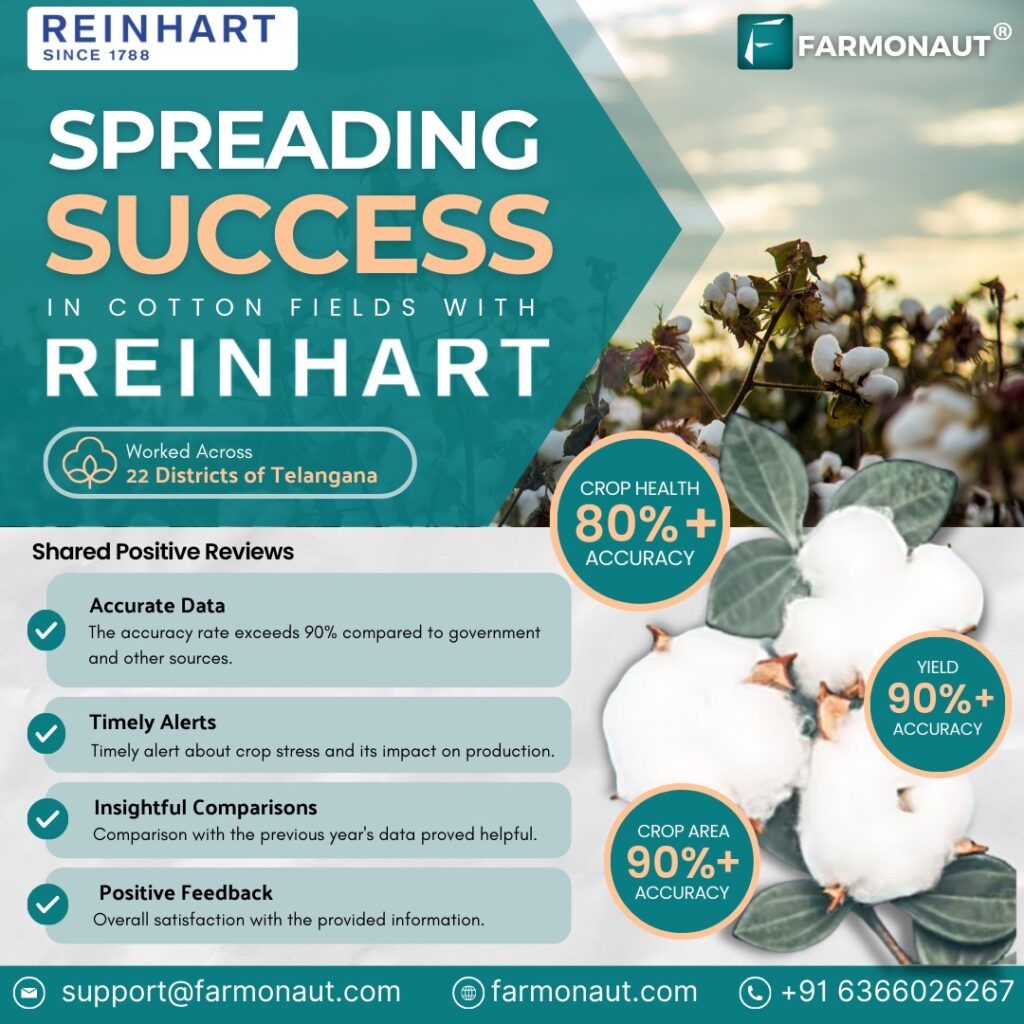Organic Pest Control for Cacao Trees: Combating Mealybugs and Swollen Shoot Disease

In the world of agriculture and horticulture, cacao trees hold a special place. These remarkable plants are the source of one of the world’s most beloved treats: chocolate. However, like all crops, cacao trees face their fair share of challenges, particularly when it comes to pest infestations and diseases. At Farmonaut, we understand the importance of protecting these valuable trees while maintaining sustainable and environmentally friendly practices. In this comprehensive guide, we’ll explore organic pest control methods for cacao trees, with a special focus on combating mealybugs and swollen shoot disease.
Understanding Cacao Trees and Their Vulnerabilities
Cacao trees (Theobroma cacao) are native to the tropical regions of Central and South America. These evergreen trees thrive in warm, humid environments and require specific conditions to produce high-quality cacao beans. However, these same conditions that promote healthy growth can also create an ideal environment for pests and diseases to flourish.
Some of the most common threats to cacao trees include:
- Mealybugs
- Swollen shoot disease
- Black pod rot
- Mirids (capsid bugs)
- Witches’ broom disease
In this article, we’ll focus primarily on mealybugs and swollen shoot disease, as these are two of the most prevalent and damaging issues facing cacao farmers today.
The Mealybug Menace: Understanding the Pest
Mealybugs are small, soft-bodied insects that belong to the family Pseudococcidae. These pests are a significant threat to cacao trees due to their ability to multiply rapidly and cause extensive damage to the host plant.
Characteristics of Mealybugs
- Appearance: Mealybugs are typically covered in a white, waxy substance that gives them a cottony or mealy appearance.
- Size: Adult females are usually 2-4 mm long, while males are smaller and winged.
- Behavior: They tend to cluster in groups on various parts of the cacao tree, including leaves, branches, and pods.
How Mealybugs Damage Cacao Trees
Mealybugs cause harm to cacao trees in several ways:
- Sap Feeding: These pests use their piercing-sucking mouthparts to extract sap from the tree, weakening it over time.
- Honeydew Production: As they feed, mealybugs excrete a sticky substance called honeydew, which can lead to the growth of sooty mold on leaves and pods.
- Virus Transmission: Some species of mealybugs can act as vectors for plant viruses, including the cacao swollen shoot virus.
- Attracting Other Pests: The honeydew produced by mealybugs often attracts ants, which can protect the mealybugs from natural predators and further complicate pest control efforts.
Swollen Shoot Disease: A Devastating Threat
Cacao swollen shoot virus (CSSV) is a serious disease that affects cacao trees, causing significant economic losses in many cacao-producing regions, particularly in West Africa.
Understanding Swollen Shoot Disease
- Causal Agent: The disease is caused by the cacao swollen shoot virus, a member of the Badnavirus genus.
- Transmission: CSSV is primarily transmitted by several species of mealybugs, highlighting the interconnected nature of pest and disease management in cacao cultivation.
- Impact: Infected trees experience reduced yields and may die within 3-5 years of infection, leading to substantial economic losses for farmers.
Symptoms of Swollen Shoot Disease
Recognizing the symptoms of swollen shoot disease is crucial for early detection and management. Common symptoms include:
- Swollen Shoots: As the name suggests, infected trees develop swollen shoots and stems.
- Leaf Discoloration: Leaves may show red vein banding or chlorosis (yellowing).
- Stunted Growth: Infected trees often exhibit reduced growth and smaller leaves.
- Pod Deformation: Cacao pods may become misshapen or develop a marbled appearance.
- Die-back: In severe cases, branches and eventually the entire tree may die.
The Case for Organic Pest Control in Cacao Cultivation
At Farmonaut, we strongly advocate for organic pest control methods in cacao cultivation. While conventional chemical treatments may offer quick results, they often come with significant drawbacks that can impact both the environment and the long-term sustainability of cacao production.
Advantages of Organic Pest Control
- Environmental Protection: Organic methods minimize harm to beneficial insects, soil microorganisms, and surrounding ecosystems.
- Improved Soil Health: By avoiding harsh chemicals, organic practices help maintain soil fertility and structure.
- Safer for Farmers: Organic pest control reduces farmers’ exposure to potentially harmful chemical pesticides.
- Consumer Demand: There’s a growing market for organically produced cacao and chocolate products.
- Long-term Sustainability: Organic methods promote a balanced agroecosystem that is more resilient to pest outbreaks over time.
Organic Pest Control Strategies for Mealybugs
Effectively managing mealybug infestations in cacao trees requires a multi-faceted approach. Here are some organic control methods that we recommend:
1. Cultural Control
- Pruning: Regular pruning helps improve air circulation and reduces hiding spots for mealybugs.
- Sanitation: Remove and destroy heavily infested plant parts to prevent the spread of mealybugs.
- Ant Management: Control ant populations, as they often protect mealybugs from natural predators.
2. Biological Control
Introducing natural predators and parasitoids can be an effective way to control mealybug populations:
- Ladybugs: Several species of ladybugs feed on mealybugs.
- Lacewings: Both adults and larvae of lacewings are voracious predators of mealybugs.
- Parasitic Wasps: Certain wasp species lay their eggs in mealybugs, effectively controlling their populations.
3. Botanical Insecticides
Natural plant-based insecticides can be effective against mealybugs while being less harmful to beneficial insects:
- Neem Oil: Derived from the neem tree, this oil disrupts mealybug feeding and reproduction.
- Pyrethrin: Extracted from chrysanthemum flowers, pyrethrin is effective against a wide range of insects.
- Garlic and Chili Spray: A homemade mixture of garlic and chili can repel mealybugs.
4. Physical Control
- Water Sprays: High-pressure water sprays can dislodge mealybugs from trees.
- Sticky Traps: Place yellow sticky traps around the cacao trees to capture adult male mealybugs.
- Manual Removal: For small infestations, manually removing mealybugs with a cotton swab dipped in alcohol can be effective.
Organic Management Strategies for Swollen Shoot Disease
Managing swollen shoot disease organically presents unique challenges, as there is no cure for infected trees. However, several strategies can help prevent and mitigate the impact of the disease:
1. Prevention and Quarantine
- Use of Virus-Free Planting Material: Ensure that all new cacao seedlings are certified virus-free.
- Quarantine Measures: Implement strict quarantine procedures to prevent the introduction of infected plant material into unaffected areas.
2. Mealybug Control
Since mealybugs are the primary vectors of CSSV, controlling their populations is crucial in managing the disease. Implement the organic mealybug control methods mentioned earlier.
3. Resistant Varieties
Plant cacao varieties that show resistance or tolerance to CSSV. Research institutions and breeding programs are continuously working on developing resistant cultivars.
4. Barrier Crops
Plant non-host tree species around cacao plantations to create physical barriers that can slow the spread of the virus.
5. Removal of Infected Trees
While not strictly an organic method, removing and destroying infected trees is often necessary to prevent the spread of the disease. This should be done in conjunction with replanting using resistant varieties.
The Role of Technology in Organic Pest Management
At Farmonaut, we believe that technology plays a crucial role in enhancing organic pest management strategies for cacao trees. Our satellite-based farm management solutions offer several benefits for cacao farmers:
- Early Detection: Our advanced satellite imagery can help detect signs of stress in cacao trees before symptoms become visible to the naked eye, allowing for early intervention.
- Precision Monitoring: Farmers can track the health of their cacao plantations over time, identifying areas that may be more susceptible to pest infestations or disease outbreaks.
- Targeted Treatment: By providing detailed maps of plantation health, our technology enables farmers to apply organic treatments more precisely, reducing waste and improving efficacy.
- Data-Driven Decision Making: Our AI-powered advisory system, Jeevn AI, analyzes satellite data and other inputs to provide customized recommendations for organic pest management.
To learn more about how Farmonaut’s technology can support your organic cacao farming efforts, visit our app page or explore our API documentation.
Conventional vs. Organic Pest Control: A Comparison
To better understand the benefits of organic pest control methods for cacao trees, let’s compare them to conventional chemical approaches:
| Aspect | Conventional Methods | Organic Methods | Farmonaut Satellite System Benefits |
|---|---|---|---|
| Effectiveness | Quick results, but may lead to pest resistance over time | Slower initial results, but more sustainable long-term control | Early detection of pest issues for timely organic interventions |
| Environmental Impact | Can harm beneficial insects and soil microorganisms | Minimal impact on non-target organisms and ecosystem | Supports targeted application of organic treatments, reducing environmental impact |
| Cost | Initially lower, but may increase due to pest resistance | Higher initial investment, but more cost-effective in the long run | Optimizes resource use, potentially reducing overall pest management costs |
| Worker Safety | Potential health risks from chemical exposure | Safer for farm workers and surrounding communities | Reduces need for frequent pesticide applications, enhancing worker safety |
| Market Value | Standard market prices | Potential for premium prices for organic cacao | Provides data to support organic certification and traceability |
Implementing an Integrated Organic Pest Management Program
To effectively combat mealybugs and swollen shoot disease in cacao plantations, we recommend implementing an integrated organic pest management (IPM) program. This approach combines various strategies to create a comprehensive and sustainable pest control system.
Key Components of an Organic IPM Program for Cacao
- Regular Monitoring: Conduct frequent inspections of your cacao trees to detect pest problems early. Farmonaut’s satellite monitoring can complement on-ground observations.
- Preventive Measures: Implement cultural practices that promote tree health and create unfavorable conditions for pests and diseases.
- Biological Control: Encourage and introduce natural predators of mealybugs and other pests.
- Organic Treatments: Use botanical insecticides and other organic pest control methods when necessary.
- Record Keeping: Maintain detailed records of pest populations, treatments applied, and their effectiveness. Farmonaut’s platform can help organize and analyze this data.
- Continuous Education: Stay informed about the latest organic pest control methods and cacao farming best practices.
Case Study: Successful Organic Mealybug Control in a West African Cacao Plantation
To illustrate the effectiveness of organic pest control methods, let’s examine a hypothetical case study of a cacao plantation in West Africa that successfully managed a severe mealybug infestation using organic techniques.
Background
- Location: Ghana
- Plantation Size: 10 hectares
- Problem: Severe mealybug infestation affecting 40% of trees
Implemented Strategies
- Pruning and Sanitation: Removed heavily infested branches and improved air circulation.
- Biological Control: Released ladybugs and lacewings as natural predators.
- Neem Oil Application: Applied neem oil solution to affected trees on a bi-weekly basis.
- Ant Management: Implemented organic ant control measures to disrupt the symbiotic relationship between ants and mealybugs.
- Satellite Monitoring: Utilized Farmonaut’s satellite imagery to track plantation health and identify hotspots of infestation.
Results
- After 3 months: Mealybug population reduced by 60%
- After 6 months: Infestation contained to less than 10% of trees
- After 1 year: Mealybug population stabilized at manageable levels, with minimal impact on yield
Key Takeaways
This case study demonstrates that with a comprehensive organic approach and the support of technology like Farmonaut’s satellite monitoring, it’s possible to effectively manage severe pest infestations in cacao plantations without resorting to harmful chemical pesticides.
The Future of Organic Pest Control in Cacao Farming
As we look to the future, several emerging trends and technologies are poised to further enhance organic pest control methods for cacao trees:
1. Advanced Biocontrol Agents
Researchers are continually discovering and developing new species of beneficial insects and microorganisms that can more effectively control cacao pests. These specialized biocontrol agents promise to offer even more targeted and efficient pest management solutions.
2. Pheromone-based Strategies
The use of insect pheromones for mating disruption or mass trapping is an emerging area in organic pest control. For cacao, pheromone-based methods could provide a highly specific and environmentally friendly way to manage mealybug populations.
3. Nanotechnology in Organic Formulations
Advances in nanotechnology are enabling the development of more effective organic pesticide formulations. Nanoencapsulation of botanical insecticides, for example, can improve their stability and efficacy while reducing the frequency of applications.
4. Genetic Techniques for Pest Resistance
While not strictly an organic method, advances in genetic techniques such as CRISPR may lead to the development of cacao varieties with enhanced natural resistance to pests and diseases, reducing the need for interventions.
5. AI and Machine Learning in Pest Detection
At Farmonaut, we’re continuously improving our AI and machine learning algorithms to provide even more accurate and early detection of pest and disease issues in cacao plantations. This technology will enable farmers to take proactive measures before infestations become severe.
6. Integrated Data Platforms
The future of organic pest management lies in integrating various data sources – from satellite imagery and weather data to on-ground sensors and historical pest records. Farmonaut is at the forefront of developing such integrated platforms to provide holistic pest management solutions.
Conclusion: Embracing Organic Pest Control for Sustainable Cacao Production
As we’ve explored throughout this comprehensive guide, organic pest control methods offer a sustainable and effective approach to managing mealybugs and swollen shoot disease in cacao trees. By embracing these techniques, cacao farmers can protect their crops, preserve the environment, and meet the growing consumer demand for organically produced chocolate.
At Farmonaut, we’re committed to supporting cacao farmers in their transition to organic pest management practices. Our advanced satellite-based farm management solutions provide the data and insights needed to implement these methods effectively and efficiently.
By combining traditional organic farming wisdom with cutting-edge technology, we believe that the future of cacao cultivation can be both productive and sustainable. Together, we can ensure that chocolate lovers around the world can continue to enjoy their favorite treat while supporting environmentally friendly farming practices.
To learn more about how Farmonaut can support your organic cacao farming efforts, visit our website or download our app:
For developers interested in integrating our satellite and weather data into their own systems, check out our API documentation.
FAQs: Organic Pest Control for Cacao Trees
-
Q: How long does it take to see results from organic pest control methods?
A: Results from organic pest control methods can take longer to become apparent compared to chemical treatments. Typically, you may start seeing improvements within 2-4 weeks, but it can take several months to achieve full control, depending on the severity of the infestation.
-
Q: Are organic pest control methods as effective as chemical pesticides?
A: While organic methods may not provide the immediate knockdown effect of chemical pesticides, they can be equally effective in the long term. Organic approaches focus on creating a balanced ecosystem that naturally suppresses pest populations, leading to more sustainable control over time.
-
Q: How can Farmonaut’s technology help in implementing organic pest control?
A: Farmonaut’s satellite-based monitoring system can detect early signs of stress in cacao trees, allowing farmers to identify potential pest issues before they become severe. Our technology also helps in targeted application of organic treatments and tracking the effectiveness of pest control measures over time.
-
Q: Is it possible to completely eradicate swollen shoot disease using organic methods?
A: Complete eradication of swollen shoot disease is challenging, even with conventional methods. Organic approaches focus on prevention, early detection, and management to minimize the spread and impact of the disease. This includes controlling vector populations (mealybugs) and removing infected trees.
-
Q: How often should I monitor my cacao trees for pests and diseases?
A: Regular monitoring is crucial for effective pest management. We recommend weekly visual inspections of your cacao trees, especially during peak growing seasons. Additionally, using Farmonaut’s satellite monitoring provides continuous oversight, alerting you to potential issues between on-ground inspections.
Subscribe to Farmonaut
Ready to take your cacao farming to the next level with Farmonaut’s advanced satellite monitoring and AI-powered insights? Subscribe to our service today:















In this blog, explore effective organic pest control methods for cacao trees. Discover how to combat mealybugs and swollen shoot disease while promoting healthy growth and sustainable farming practices.